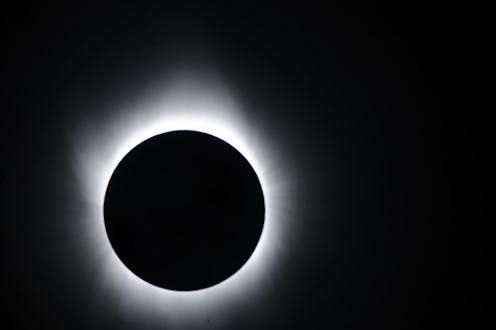Life
How To Tell If Your Solar Eclipse Glasses Are Fake

You thought you were ready for the eclipse on Aug. 21. You asked for time off from work, you bought a viewing party ticket, and you even snagged some solar eclipse glasses before they started selling out. But then the news broke: Some less-than-scrupulous vendors have reportedly been selling fake solar eclipse glasses. They might look like the real, dorky deal, but they fail to meet the criteria for eye protection outlined by NASA. On top of being a bad business move, this is super unsafe — a spokesperson for the American Astronomical Society told the Washington Post that using unverified solar glasses can "literally cook your retina." Yikes.
In the interest of keeping your eyes un-cooked, you would probably like to know how to tell if your eclipse glasses are real. Unfortunately, you can't check to see if they meet the international safety standard yourself. According to the American Astronomical Society (AAS), that would involve some complicated scientific equipment. Instead, the glasses are tested in specialized labs, and once they have been verified, manufacturers can use the ISO label.
But that doesn't mean you can check your glasses for the ISO label and call it a day. The AAS warns that some of the aforementioned nefarious sellers have been simply printing out the label on their own.
Unscrupulous vendors can grab the ISO logo off the internet and put it on their products and packaging even if their eclipse glasses or viewers haven't been properly tested. This means that just seeing the ISO logo or a label claiming ISO 12312-2 certification isn't good enough. You need to know that the product comes from a reputable manufacturer or one of their authorized dealers.
So how are you supposed to know your protective glasses will actually protect you? Head over to the AAS website, where you can find a list of reputable eye protection vendors that sell solar filters compliant with the ISO 12312-2 safety standard. American Paper Optics has an Amazon-approved list of vendors as well. The AAS notes that it's not an exhaustive list, and there could be other genuine sellers out there. If you bought glasses of an approved brand from one of the companies listed on the pages, though, you should be okay.
Even if they come from a reputable vendor, you can also check the glasses yourself to make sure they actually work. The AAS writes that you shouldn't be able to see anything except the sun or something comparably bright through the glasses. "If you can see shaded lamps or other common household light fixtures (not bare bulbs) of more ordinary brightness through your eclipse glasses or handheld viewer, and you're not sure the product came from a reputable vendor, it’s no good," the organization writes.
Similarly, you should be able to comfortably look at the sun. If it's hazy or out of focus, the glasses may not be functioning correctly. You'll also want to make sure they're not torn or scratched in any way.
So what happens if your glasses are questionable? Most vendors ran out of stock days ago, and the closer we get to the eclipse, the less likely it is that you'll find new glasses. Womp, womp. But that doesn't mean you can't watch the eclipse anyway. NASA will be livestreaming the event, and the AAS has instructions for safe viewing through pinhole and optical projection — no glasses required.
A total solar eclipse may be rare, but it's not that rare. The next one to pass over the United States will be in 2024. If you suspect your glasses are fake, catching a glimpse of the eclipse isn't worth potentially permanent eye damage. Don't you want to be able to watch the next one?